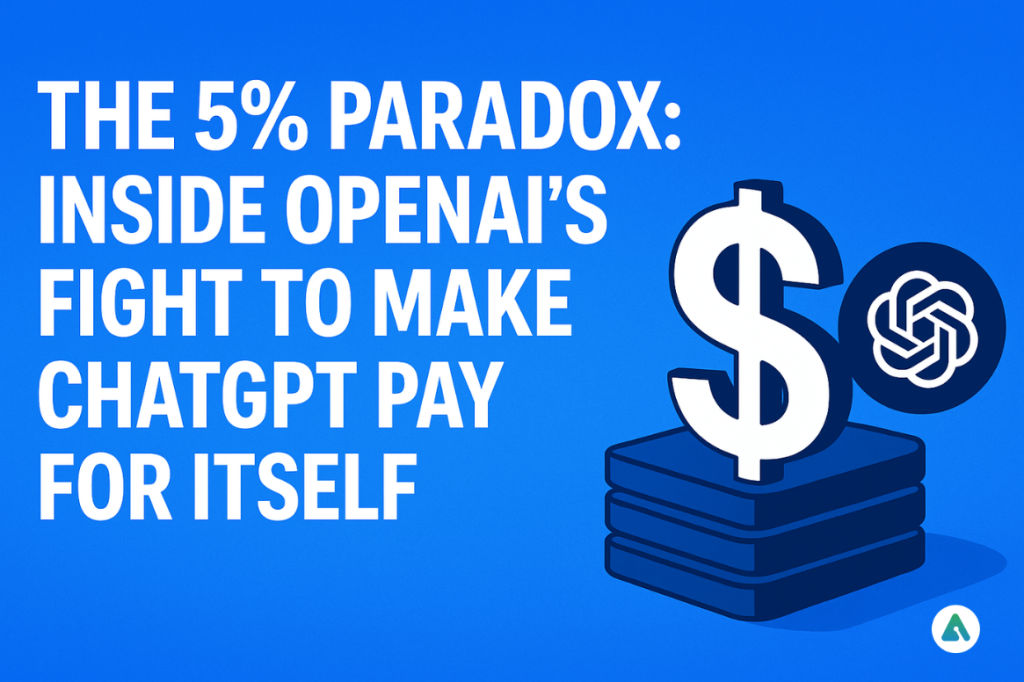Artificial intelligence is having its golden moment — and at the center of it all sits OpenAI, the company that turned a chatbot into a global habit. From classrooms to corporations, ChatGPT has become the go-to digital assistant for millions. Yet behind the success story lies a harsh economic riddle: only about 5% of those users actually pay.
That imbalance is now shaping OpenAI’s future. Futurism report estimates the company may need to spend over $1 trillion in computing power — often referred to as the “OpenAI trillion dollar compute cost” — over the coming years to keep pace with demand. It’s an almost unthinkable figure, even for Silicon Valley’s best-funded players.
The irony is hard to miss: ChatGPT is the most popular AI product on the planet, but it’s running on an economic model that’s starting to strain under its own success. The AI boom is booming — but so are the cracks forming beneath it.
The 5% That Carries the World
ChatGPT has become a daily utility — part personal assistant, part creative partner, part research engine. Yet, 95% of its users don’t pay a cent. That’s not a minor hiccup; it’s a fundamental business challenge.
Running large language models isn’t cheap. Every query requires expensive GPU cycles, and inference costs balloon with user scale. When millions rely on free usage, margins evaporate fast. Analysts say that for every thousand free prompts, OpenAI burns dollars in compute costs — an unsustainable loop for a company still searching for a balance between accessibility and profitability.
The Compute Crunch Is Real
OpenAI’s ambitions stretch far beyond text generation. From Sora, its upcoming video generation model that’s already stirring deepfake concerns, to its multimodal capabilities and enterprise integrations, the scale of compute needed is unlike anything the tech world has faced before.
According to financial projections, maintaining and upgrading the infrastructure required to keep these systems running could top $100 billion annually by the decade’s end — especially if usage continues its exponential climb.
And that’s not counting the data centers, energy consumption, and high-end GPU demands — a market currently dominated by NVIDIA, with a near-monopoly on AI hardware.
How OpenAI Is Fighting Back
To combat this growing “compute crisis,” OpenAI isn’t standing still. Several strategic moves are already in motion:
- The $10 Billion Chip Alliance – In one of the boldest moves of 2025, OpenAI teamed up with AMD to co-develop custom AI chips — a bid to cut dependency on NVIDIA and drive down GPU costs. The partnership aims to create scalable, efficient infrastructure for future models.
- Enterprise Expansion – OpenAI has pivoted its strategy to attract more business clients through ChatGPT Enterprise and API integrations. While everyday users chase life hacks, OpenAI’s real revenue hopes lie in corporate adoption.
- Optimized Model Efficiency – Engineers have been working on lightweight model variants to reduce inference costs. These include adaptive compute mechanisms that use smaller models for simple queries, reserving the larger GPT-5 backbone for complex reasoning.
- Revenue Diversification – Beyond subscriptions, OpenAI is exploring partnerships with creative studios, educational tools, and enterprise copilots to expand its income streams. This diversification mirrors the approach of Google and Microsoft, which leverage AI across ecosystems rather than relying on direct monetization.
The Shadow of an AI Bubble
While OpenAI grapples with operational costs, analysts are questioning whether the AI boom might morph into an AI bubble. NPR recently highlighted how overvaluation, inflated expectations, and infrastructure costs could mirror the dot-com crash of the early 2000s — only this time, with GPUs instead of servers.
But OpenAI seems aware of the risks. Its leadership, led by CEO Sam Altman, has been vocal about aligning innovation with sustainability, emphasizing long-term AI development rather than chasing quarterly revenue hype.
Competitive Pressures Mounting
As rivals like Google’s Gemini push hard into the same market, OpenAI’s ability to optimize infrastructure and reduce dependency will determine whether it leads the AI era or gets swallowed by it. Gemini’s integration with Google Search and Android devices gives it a built-in user advantage — one OpenAI hopes to counter with deep integrations across Microsoft’s ecosystem and a continued edge in conversational AI.
Meanwhile, the company continues to experiment with consumer engagement. From quirky model updates to controversial releases like the ChatGPT erotica content filter update, OpenAI is probing where boundaries meet monetization.
The Road Ahead
OpenAI’s current trajectory is a paradox — massive cultural relevance fueled by a user base that doesn’t pay. Yet, its strategic pivots suggest a company ready to evolve. Whether through chip partnerships, enterprise scaling, or smarter model deployment, OpenAI is rewriting the economics of intelligence itself.
The next few years will test whether the AI revolution was a gold rush or the foundation of something lasting. Either way, OpenAI is racing not just to build the future — but to afford it.
Visit: AIInsightsNews


